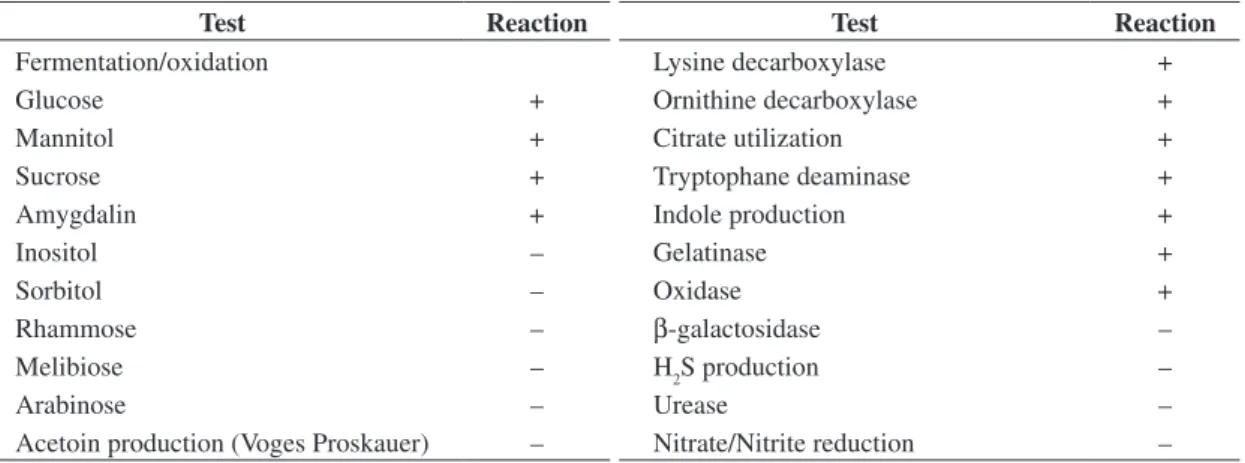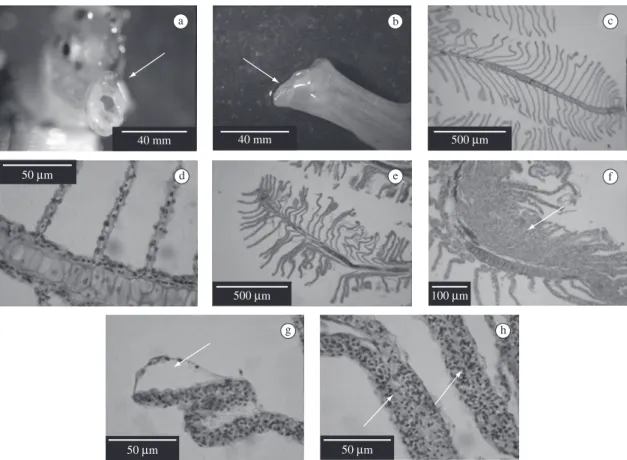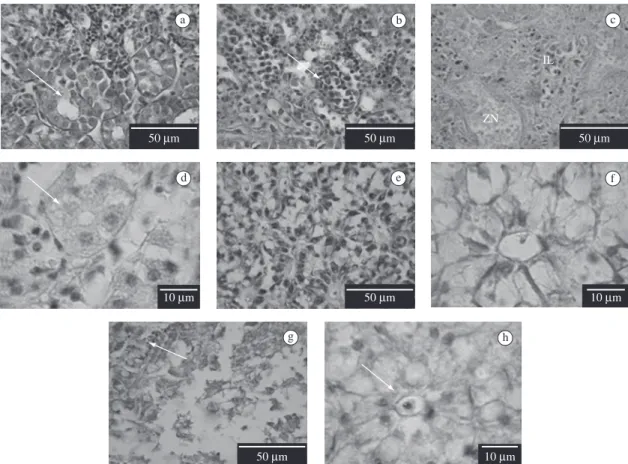in the sea horse,
Hippocampus reidi
Ginsburg, 1933
(Osteichthyes: Syngnathidae) in Brazil
Martins, ML.
a*, Mouriño, JLP.
a,b, Fezer, GF.
a, Buglione Neto, CC.
b,
Garcia, P.
a,
Silva, BC.
a,b, Jatobá, A.
a,band Vieira, FN.
a,baLaboratório AQUOS – Sanidade de Organismos Aquáticos, Centro de Ciências Agrárias – CCA, Universidade Federalde Santa Catarina – UFSC,
Rod. Ademar Gonzaga, 1346, CEP 88040-900, Florianópolis, SC, Brazil b Laboratório de Camarões Marinhos – LCM, Centro de Ciências Agrárias – CCA,
Universidade Federalde Santa Catarina – UFSC
Servidão dos Coroas, fundos, Barra da Lagoa, CEP 88062-601, Florianópolis, SC, Brazil *e-mail: mlaterca@cca.ufsc.br
Received October 22, 2008 – Accepted December 23, 2008 – Distributed February 28, 2010 (With 2 figures)
Abstract
The aim of this study was to evaluate the pathogenicity of Vibrio alginolyticus isolated from an outbreak of sea horse Hippocampus reidi reared in the State of Santa Catarina, Brazil, by experimental infection. Sea horses with
necro-sis on the mouth epithelium were collected from aquaria at the Aquaculture Department, UFSC and the bacterium isolated from the mouth, liver, heart and blood in tiosulphate citrate bilesalt sucrose agar broth. The strains were identified by API 20E kit with 99.1% probability as Vibrio alginolyticus. Twelve adult sea horses (9.63 ± 2.42 g and
15.12 ± 0.87 cm) were distributed in six aquaria of 10 L capacity with aerated sea water. Fish from three aquaria were submitted to an immersion bath in a solution containing 1.0 × 107 CFU of V. alginolyticus/mL for 15 minutes. Fish
from the other three aquaria received the same procedure without bacteria. Twenty four hours after this challenge, 100% mortality was observed in the animals infected with V. alginolyticus. No mortality was observed in non-infected
fish. Hyperplasia, displacement and fusion of secondary lamellae of the gills; leukocyte infiltration and necrotic foci in the kidney; hyperplasia, sinusoidal deformation and necrotic foci in the liver were observed in histopathological analysis. The V. alginolyticus isolated in this study was pathogenic to H. reidi and constitutes an important sanitary
problem to its culture.
Keywords: experimental infection, vibriosis, histopathology.
Isolamento e infecção experimental de
Vibrio alginolyticus
em cavalo-marinho,
Hippocampus reidi
Ginsburg, 1933 (Osteichthyes: Syngnathidae) no Brasil
Resumo
Foi avaliado por meio de infecção experimental a patogenicidade de Vibrio alginolyticus isolado de um surto de enfermidade em cavalo-marinho Hippocampus reidi cultivado no Estado de Santa Catarina, Brasil. Os peixes com
necroses no epitélio bucal foram coletados em aquários do Departamento de Aquicultura, UFSC e as bactérias iso-ladas da boca, fígado, coração e sangue em meio Agar tiossulfato citrato bile sacarose. Os isolados foram identifica-dos pelo kit API 20E como Vibrio alginolyticus com 99,1% de probabilidade. Doze peixes adultos (9,63 ± 2,42 g e 15,12 ± 0,87 cm) foram distribuídos em seis aquários de 10 L com água marinha e aeração. Peixes de três aquários foram submetidos a um banho de imersão por 15 minutos em uma solução contendo 1,0 × 107 UFC de V. alginolyticus/
mL. Nos outros três aquários realizou-se o mesmo procedimento sem a bactéria. Vinte e quatro horas após o desafio, 100% de mortalidade foi observada nos animais infectados com V. alginolyticus. Não houve mortalidade nos peixes não infectados. Nas análises histopatológicas, foi observado hiperplasia, deslocamento do epitélio e fusão das lamelas secundárias das brânquias; infiltração de leucócitos e necrose no rim; hiperplasia, deformação sinusoidal e necrose no fígado nos animais desafiados com V. alginolyticus. O V. alginolyticus isolado neste estudo foi patogênico para H. reidi, constituindo-se de um importante problema para seu cultivo.
1. Introduction
The sea horse Hippocampus reidi is native to the
Brazilian littoral (Dias and Rosa, 2003), and found fixed on mangrove vegetation, algae, Coelenterata and Bryozoa (Rosa et al., 2007). They can be found near the surface (Rosa et al., 2002) up to 55 m depth (Lourie et al., 1999), distributed along the Atlantic coast from Rio de Janeiro to the Gulf of Mexico (Rosa et al., 2002). The Brazilian Environmental Ministry (Normative instruction 05/2004) considers the species to be under threat. Due to lack of information on their biology in nature, they are classi-fied as “Data Deficient” on the Red List of Threathened Species (IUNC, 2008).
Sea horses are appreciated in the ornamental indus-try (Giwojna, 2002), popular medicine and are souvenir objects (Foster and Vincent, 2004). Every year, thou-sands of sea horses are exported from Latin America to the United States and Europe (Baum and Vincent, 2005). According to Monteiro-Neto et al. (2003) and Rosa et al. (2005, 2006), Brazil is one of the most important export-ers of H. reidi.
The majority of commercialised sea horses in Latin America are from capture (Baum and Vincent, 2005), which, allied to pollution and human interference in the ecosystem (Hodgson, 1999), cause reduction in the natu-ral stocks of this fish (Baum and Vincent, 2005).
The reproduction of H. reidi in captivity is an
al-ternative for international trade to avoid uncontrolled capture (Felício et al., 2006). On the other hand, their reproduction in captivity is difficult (Giwojna, 2002) and bacterial infections are the main obstacle to produce this fish species (Alcaide et al., 2001).
Among bacterial diseases in marine fishes, Vibrio
ssp. is one of the most important causes of economic losses. This bacterium is normally found in the marine environment and the disease outbreaks occur when fish are exposed to infectious agents in the presence of stress factors (Austin and Austin, 2007). Septicemia induced by vibriosis is characterised by haemorrhages on the fin base, exoftalmia, loss of appetite and edematous lesions
on the body surface (Toranzo et al., 2005). The studies on sea horse pathology are scarce and they have recently been affected by vibriosis as reported by Alcaide et al. (2001) with mortalities of more than 90%. These authors reported the main clinical signs as external es, loss of skin colour, depressed abdomen, haemorrhag-ic liver, pale kidney and ascithaemorrhag-ic fluid in the intestines. In Brazil, nothing is known on sea horse pathology espe-cially in experimental infection conditions.
This assay evaluated by experimental infection the pathogenicity of Vibrio alginolyticus to H. reidi isolated from an outbreak in sea horses reared in the State of Santa Catarina, south Brazil.
2. Material and Methods
Bacterial strains were isolated from an outbreak of sea horses reared at the Aquaculture Department, Federal University of Santa Catarina (UFSC) and the experi-mental infection occurred at the Research Laboratory of Aquatic Organisms Health, UFSC. Samples were col-lected from mouth lesions, blood, heart and liver for inoculation onto tiosulphate citrate bilesalt sucrose agar (TCBS, DifcoTM), selective to vibrionaceae. Plates were
incubated for 24 hours at 30 °C and the colonies were isolated on tryptone soy agar (TSA) to obtain a pure cul-ture for identification with the API 20E (Biomeriux®)
kit.
Twelve adult sea horses (9.63 ± 2.42 g weight and 15.12 ± 0.87 cm length) were distributed in six aquaria with 10 L marine water in a completely randomised de-sign. Lines of 2 cm diameter were fixed to the bottom of the aquaria to support the fish. Water temperature was maintained at 26 ± 1 °C with constant aeration. Fish from three aquaria were submitted to an immersion bath in a solution containing 1.0 × 107 colony forming units
(CFU) of V. alginolyticus/mL for 15 minutes. Fish from the other three aquaria were submitted to the same pro-cedure without bacteria.
Twenty four hours after challenged, the survival rate was noted and the surviving fishes (infected and
non-Table 1. Characteristics of Vibrio alginolyticus isolated from sea horse, Hippocampus reidi in the State of Santa Catarina, South Brazil. (+) positive reaction, (–) negative reaction.
Test Reaction Test Reaction
Fermentation/oxidation Lysine decarboxylase +
Glucose + Ornithine decarboxylase +
Mannitol + Citrate utilization +
Sucrose + Tryptophane deaminase +
Amygdalin + Indole production +
Inositol – Gelatinase +
Sorbitol – Oxidase +
Rhammose – β-galactosidase –
Melibiose – H2S production –
Arabinose – Urease –
infected) were anesthetised in a benzocaine solution (50 mg.L–1), sacrificed and immediately fixed for
histol-ogy by placing the organs in 10% buffered formalin. All samples were embedded in paraffin wax and processed using standard histological procedures and the 5 µm sec-tions (microtome Olympus CUT 4055) stained with hae-matoxylin and eosin (H and E).
3. Results and Discussion
Four bacterial strains were isolated from the outbreak of sea horses (lesions on the mouth, liver, heart and blood). All those isolated were identified as Vibrio alginolyticus
with 99.1% of probability by the API test (Table 1). Bacteria from the genus Vibrio are frequently isolated from outbreaks in marine fish such as V. alginolyticus in
the gilthead seabream Sparus aurata (Akaayli et al., 2008),
V.harveyi in seabass Lates calcarifer (Tendencia, 2002)
and in the summer flounder Paralichthysdentatus (Gauger et al., 2006), V. pelagius in turbot Scophthalmus maximus
(Villamil et al., 2003), V. splendidus and V. scophthalmi
in common dentex Dentexdentex (Sitjà-Bobadilla et al.,
2007). In sea horses, Alcaide et al. (2001) reported
V. harveyi from an outbreak in Hippocampus kuda.
Twenty four hours after the challenge, 100% mortal-ity was found in seahorses that proved the pathogenicmortal-ity
of the isolated strains. In this assay, fish presented necro-sis on the mouth epithelium similar to the animals in which the strains were originally isolated. On the other hand, in uninfected fish, neither mortality nor bacterial lesions were found corroborating the results of Alcaide et al. (2001) after infection with V. harveyi.
Histopathological analyses of uninfected fish showed normal tissues (Figures 1c,d). After infection, the gills were characterised by loss of cellular integrity (Figure 1e) such as hyperplastic epithelial cells (Figure 1f), displace-ment (Figure 1g) and fusion predominantly affected the secondary lamellae (Figure 1h). Similar gill changes were found in Atlantic salmon Salmo salar experimen-tally infected with V. anguillarum (Morrison et al., 2001) and turbot (Villamil et al., 2003). Mucous cell prolifera-tion is a host response to altered environmental condi-tions, exposure to toxicants (Mallat, 1985), parasites (Azevedo et al., 2006) and bacterial infections (Villamil et al., 2003). These gill alterations might harm the ionic changes in fish (Morrison et al., 2001) and constitute a portal of entry to other diseases (Moraes and Martins, 2004).
Normal histological structure in uninfected sea horses was observed (Figure 2a,b). On the contrary, in infected fish, the kidney was characterised by necrotic
a b c
d e f
g h
foci and leukocytic infiltration (Figure 2c,d). In these fish, deformation and cellular injury of glomerulus, contorted tubules and collector tubules were also ob-served (Figure 2c,d). Leukocytic infiltration indicates an inflammatory reaction according to the observations of Benjamin et al. (2000). The kidney’s alterations here observed were similar to the ones in turbot infected with
V. pelagius (Villamil et al., 2003) and in turbot Colistium nudipinnis with septicemia caused by V. splendidus
(Diggles et al., 2000). Diggles et al. (2000) related ex-tensive haemorrhage and necrosis in the kidney and as-sumed the evidence of pathogenic vibriosis in turbot.
The liver of uninfected sea horses showed normal histology of hepatocytes and bile ducts (Figure 2e,f). In infected fish hyperplasia, necrotic foci, sinusoidal and bile duct deformation (Figure 2g,h) were found. Our results corroborated the observations in brill Colistium guntheri suffering from septicemic bacterial by V. camp-bellii (Diggles et al., 2000) and in turbot infected by Moritellaviscosa (Björnsdóttir et al., 2004). The liver is
an organ that may be used as an indicator of alterations in nutritional or physiological status as commented by Segner and Juario (1986). However, general metabolism of fish is compromised in cases of infectious diseases.
Vibrio alginolyticus is capable of producing toxins
as serum proteases (Lee et al., 1997; Chen et al., 1999), which may be responsible for alterations in the gills, kid-ney and liver in infected fishes. These events might cause organ dysfunction by committing metabolic activities, culminating in fish death.
In conclusion, the strain of V. alginolyticus isolated was,
in fact, pathogenic to H. reidi, as there was a high mortality
in experimental infection and the observation of lesions on the mouth, gills, liver and kidney. It is important to empha-sise that vibriosis can affect the development of new tech-nologies of sea horse culture, appreciated fish in the aquar-ium trade. To minimise the effects of vibriosis in sea horse, an adequate prophylaxis combined with the use of immu-nostimulants or probiotic bacteria must be considered.
Acknowledgements — The authors are grateful to professor Elpídio Beltrame (in memoriam) for his help in accomplishing the work and to CNPq for the grant (472968/2007-6; 301072/2007-8).
References
AKAAYLI, T., TIMUR, G., AYDEMIR, B., KIZILER, AR., COSKUN, O., ALBAYRAK, G. and ARICAN, E., 2008. Characterization of Vibrio alginolyticus isolates from diseased
a b c
d e f
g h
culture gilthead sea bream, Sparus aurata. Israeli Journal of Aquaculture Bamidgeh, vol. 60, no. 2, p. 89-94.
ALCAIDE, E., GIL-SAZ, C., SANJUÁN, E., ESTEVE, D., AMARO, C. and SILVEIRA, L., 2001. Vibrio harveyi causes disease in seahorse, Hippocampus sp.Journal of Fish Diseases, vol. 24, no. 5, p. 311-313.
AUSTIN, B. and AUSTIN, D., 2007. Bacterial fish pathogens: diseases of farmed and wild fish. 4 ed. Chichester: Springer. 594 p.
AZEVEDO, TMP., MARTINS, ML., BOZZO, FR. and MORAES, FR., 2006. Haematological and gill responses in parasitized tilapia from Valley of Tijucas River, SC, Brazil. ScientiaAgricola, vol. 63, no. 2, p. 115-120.
BAUM, JK. and VINCENT, ACJ., 2005. Magnitude and inferred impacts of the seahorse trade in Latin America. Environmental Conservation,vol. 32, no. 4, p. 305-319.
BENJAMIN, E., COICO, R. and SUNSHINE, G., 2000. Immunology: a short course. 4 ed. New York: Wiley-Liss. 498 p. BJÖRNSDÓTTIR, B., GUDMUNDSDÓTTIR, S., BAMBIR, SH., MAGNADÓTTIR, B. and GUDMUNDSDÓTTIR, BK., 2004. Experimental infection of turbot, Scophthalmusmaximus (L.), by Moritella viscosa, vaccination effort and vaccine-induced side-effects. Journal ofFishDiseases, vol. 27, no. 11, p. 645-655.
CHEN, FR., LIU, PC. and LEE, KK., 199. Purification and partial characterization of a toxic serine protease produced by pathogenic Vibrioalginolyticus. Microbios, vol. 98, no. 390, p. 95-111.
DIAS, TLP. and ROSA, IL., 2003. Habitat preferences of a seahorse species, Hippocampus reidi (Teleostei: Syngnathidae). Journal of Ichthyology and Aquatic Biology, vol. 6, no. 4, p. 165-176.
DIGGLES, BK., CARSON, J., HINE, PM., HICKMAN, RW. and TAIT, MJ., 2000. Vibrio species associated with mortalities in hatchery-reared turbot Colistium nudipinnis and brill C. guntheri in New Zealand. Aquaculture, vol. 183, no. 1, p. 1-12. FELÍCIO, AKC., ROSA, IL., SOUTO, A. and FREITAS, RHA., 2006. Feeding behavior of the longsnout seahorse Hippocampusreidi Ginsburg, 1933. Journal of Ethology, vol. 24, no. 3, p. 219-225. FOSTER, SJ. and INCENT, ACJ., 2004. Life history and ecology of seahorses: implications for conservation and management. Journal of Fish Biology, vol. 65, no. 1, p. 1-61.
GAUGER, E., SMOLOWITZ, R., UHLINGER, K., CASEY, J. and GÓMEZ-CHIARRI, M., 2006. Vibrioharveyi and other bacterial pathogens in cultured summer flounder. Paralichthys dentatusi. Aquaculture, vol. 260, no. 1, p. 10-20.
GIWOJNA, P., 2002. Ocean rider: a horse of a different color. Freshwater and Marine Aquarium, vol. 3, no. 3, p. 122-150. HODGSON, G., 1999. A global assessment of human effects on coral reefs. Marine. Pollution Bulletin, vol. 38, no. 5, p. 345-355.
International Union for Conservation of Nature - IUCN, 2008. IUCN Red List of Threatened Species. Cambridge. International Union for Conservation of Nature and Natural Resources (Ed.). Available from: <http://www.redlist.org>. Access in: 03/08/2008.
LEE, KK., YU, SR. and LIU, PC., 1997. Alkaline serine protease is an exotoxin of Vibrioalginolyticus in kuruma prawn, Penaeus japonicus. CurrentMicrobiology, vol. 34, no. 2, p. 110-117.
LOURIE, SA., VINCENT, ACJ. and HALL, HJ., 1999. Seahorses: an identification guide to the world species and their conservation. London: Project Seahorse. 214 p.
MALLAT, J., 1985. Fish gill structural changes induced by toxicants and other irritants: a statistical review. Canadian Journal of Fisheries and Aquatic Sciences, vol. 42, no. 4, p.630-648. MONTEIRO-NETO, C., CUNHA, FEA., NOTTINGHAM, MC., ARAUJO, ME., ROSA, IL. and BARROS, GML., 2003. Analysis of the marine ornamental fish trade at Ceará State, northeast Brazil. Biodiversity Conservation, vol. 12, no. 6, p. 1287-1295.
MORAES, FR. and MARTINS, ML., 2004. Favourable conditions and principal teleostean diseases in intensive fish farming. In CYRINO, JEP., URBINATI, EC., FRACALOSSI, DM. and CASTAGNOLLI, N. (Eds.). Especial topics in tropical intensive freshwater fish farming. São Paulo: TecArt. p. 343-383.
MORRISON, RN., NOWAK, BF. and CARSON, J., 2001. The histopathological effects of a levamisole-adjuvanted Vibrio anguillarum vaccine on Atlantic salmon Salmo salar L. Aquaculture, vol. 195, no. 1, p. 23-33.
ROSA, IL., DIAS, TL. and BAUM, FK., 2002. Threatened fishes of the world: Hippocampus reidi Ginsburg, 1933 (Syngnathidae). Environmental Biology of Fishes, vol. 64, no. 4, p. 378.
ROSA, IL., SAMPAIO, CLS. and BARROS, AT., 2006. Collaborative monitoring of the ornamental trade of seahorses and pipefishes (Teleostei: Syngnathidae) in Brazil: Bahia State as a case study. Neotropical Ichthyology, vol. 4, no. 2, p. 247-252. ROSA, IL., ALVES, RRN., BONIFÁCIO, KM., MOURÃO, JS., OSÓRIO, FM., OLIVEIRA, TPR. and NOTTINGHAM, MC., 2005. Fisher’s knowledge and seahorse conservation in Brazil, Fishers’ knowledge and seahorse conservation in Brazil. Journal of Ethnobiology and Ethnomedicine, vol. 1, no. 12, p. 1-12. ROSA, IL., OLIVEIRA, TPR., CASTRO, ALC., MORAES, LES., XAVIER, JHA., NOTTINGHAM, MC., DIAS, TLP., BRUTO-COSTA, LV., ARAÚJO, ME., BIROLO, AB., MAI, ACG. and MONTEIRO-NETO, C., 2007. Population characteristics, space use and habitat associations of the seahorse Hippocampus reidi (Teleostei: Syngnathidae). Neotropical Ichthyology, vol. 5, no. 3, p. 405-414.
SEGNER, H. and JUARIO, JV., 1986. Histological observations on the rearing of milkfish, Chanoschanos, fry using different diets. Journal of Applied Ichthyology, vol. 4, p. 162-173. SITJÀ-BOBADILLA, A., PUJALTE, MJ., BERMEJO, A., GARAY, E., ALVAREZ-PELLITERO, P. and PÉREZ-SÁNCHEZ, J., 2007. Bacteria associated with winter mortalities in laboratory-reared common dentex (Dentex dentex L.). Aquaculture Research, vol. 38, no. 7, p. 733-739.
TENDENCIA, EA., 2002. Vibrioharveyi isolated from cage-cultured seabass Lates calcarifer Bloch in the Philippines. AquacultureResearch, vol. 33, no. 6, p. 455-458.
TORANZO, AE., MAGARIÑOS, B. and ROMALDE, JL., 2005. A review of the main bacterial fish diseases in mariculture systems. Aquaculture, vol. 246, no. 1, p. 37-61.


